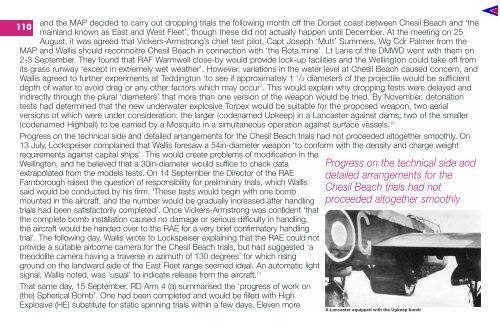Volume 5 No 2 - Royal Air Force Centre for Air Power Studies
Volume 5 No 2 - Royal Air Force Centre for Air Power Studies
Volume 5 No 2 - Royal Air Force Centre for Air Power Studies
You also want an ePaper? Increase the reach of your titles
YUMPU automatically turns print PDFs into web optimized ePapers that Google loves.
and the MAP decided to carry out dropping trials the following month off the Dorset coast between Chesil Beach and ‘the<br />
110<br />
mainland known as East and West Fleet’, though these did not actually happen until December. At the meeting on 25<br />
August, it was agreed that Vickers-Armstrong’s chief test pilot, Capt Joseph ‘Mutt’ Summers, Wg Cdr Palmer from the<br />
MAP and Wallis should reconnoitre Chesil Beach in connection with ‘the Rota mine’. Lt Lane of the DMWD went with them on<br />
2-3 September. They found that RAF Warmwell close-by would provide lock-up facilities and the Wellington could take off from<br />
its grass runway ‘except in extremely wet weather’. However, variations in the water level at Chesil Beach caused concern, and<br />
Wallis agreed to further experiments at Teddington ‘to see if approximately 1 1 /2 diameters of the projectile would be sufficient<br />
depth of water to avoid drag or any other factors which may occur’. This would explain why dropping tests were delayed and<br />
indirectly through the plural ‘diameters’ that more than one version of the weapon would be tried. By <strong>No</strong>vember, detonation<br />
tests had determined that the new underwater explosive Torpex would be suitable <strong>for</strong> the proposed weapon, two aerial<br />
versions of which were under consideration: the larger (codenamed Upkeep) in a Lancaster against dams; two of the smaller<br />
(codenamed Highball) to be carried by a Mosquito in a simultaneous operation against surface vessels. 10<br />
Progress on the technical side and detailed arrangements <strong>for</strong> the Chesil Beach trials had not proceeded altogether smoothly. On<br />
13 July, Lockspeiser complained that Wallis <strong>for</strong>esaw a 54in-diameter weapon ‘to con<strong>for</strong>m with the density and charge weight<br />
requirements against capital ships’. This would create problems of modification in the<br />
Wellington, and he believed that a 30in-diameter would suffice to check data<br />
extrapolated from the models tests. On 14 September the Director of the RAE<br />
Farnborough raised the question of responsibility <strong>for</strong> preliminary trials, which Wallis<br />
said would be conducted by his firm. ‘These tests would begin with one bomb<br />
mounted in the aircraft, and the number would be gradually increased after handling<br />
trials had been satisfactorily completed’. Once Vickers-Armstrong was confident ‘that<br />
the complete bomb installation caused no damage or serious difficulty in handling,<br />
the aircraft would be handed over to the RAE <strong>for</strong> a very brief confirmatory handling<br />
trial’. The following day, Wallis wrote to Lockspeiser explaining that the RAE could not<br />
provide a suitable airborne camera <strong>for</strong> the Chesil Beach trials, but had suggested ‘a<br />
theodolite camera having a traverse in azimuth of 130 degrees’ <strong>for</strong> which rising<br />
ground on the landward side of the East Fleet range seemed ideal. An automatic light<br />
signal, Wallis noted, was ‘usual’ to indicate release from the aircraft. 11<br />
That same day, 15 September, RD Arm 4 (a) summarised the ‘progress of work on<br />
(the) Spherical Bomb’. One had been completed and would be filled with High<br />
Explosive (HE) substitute <strong>for</strong> static spinning trials within a few days. Eleven more<br />
Progress on the technical side and<br />
detailed arrangements <strong>for</strong> the<br />
Chesil Beach trials had not<br />
proceeded altogether smoothly<br />
A Lancaster equipped with the Upkeep bomb
















